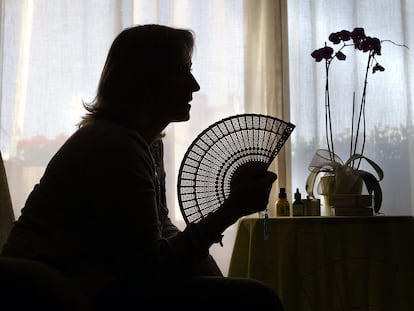The limits of hormone therapy for menopause
The scientific community settles doubts about these drugs after a study warned they increased the risk of cancer: they provide effective relief for severe symptoms in healthy young postmenopausal women

Menopausal hormone therapy has been used, abused and avoided for years. These treatments replace the hormones that the uterus stops making once a woman’s periods end. Last century, hormonal therapy was used as a sort of elixir for eternal youth and femininity; it was presented as the perfect cocktail for relieving postmenopausal hot flashes and preventing chronic diseases. But these treatments fell out of favor when a 2002 study associated their use with increased risks of developing cancer and other illnesses. Since then, the medical community has recalibrated the risks, benefits and recommendations. But even today, the concerns that emerged with the 2002 study persist among doctors and patients. However, scientific researchers have settled the debate: hormone therapy is not recommended for preventing chronic diseases, but its use is encouraged as an effective treatment for severe symptoms of menopause, such as hot flashes.
Each woman is different, and no two menopauses are the same. Menstruation usually ends between the ages of 45 and 55, and the climacteric transition between childbearing age and the end of menstrual cycles varies a great deal. The symptoms (if there are any) and their intensity depend on each case. 80% of women experience a symptom associated with menopause, albeit to varying degrees. In fact, we do not know the precise prevalence of moderate to severe vasomotor problems (e.g., hot flashes, vaginal dryness, night sweats, etc.); one study indicated that in Europe it was 40%; in the United States, 34%; and in Japan, 16%.
The experts consulted by EL PAÍS agree that, when severe, these symptoms greatly reduce the quality of life. Hormone therapy with estrogens and progesterone continues to be the most effective treatment for alleviating them, said María Jesús Cancelo, the vice president of the Spanish Society of Gynecology (SEGO). “There has been a lot of research and different ways of understanding hormone therapy. Today, it is a treatment for relieving symptoms. [In the past,] it was also used to prevent chronic diseases; before, [hormone therapy] was thought to be a treatment for eternal youth,” she summarized.
In the 1960s, the notion of “feminine forever” saturated common discourse around menopause; it was the motto associated with “the change” and even a book title. At the time, this transition was seen as an ideological scourge and understood as a disease. The onset of menopause, during which menstruation ends and ovarian activity ceases, involves a drop in the production of female hormones, such as estrogens and progesterone, which influence the regulation of many organic processes. Thus, hormone replacement therapy emerged as a liberating treatment for preserving femininity, alleviating the symptoms of menopause and even preventing cardiovascular diseases and cancer.
The WHI study’s impact
Hormonal therapy was widely used, especially in the United States, until 2002, when the publication of the Women’s Health Initiative (WHI) study upended previous evidence. After studying over 16,600 healthy postmenopausal women between the ages of 50 and 79 who were given estrogen and progesterone hormone therapy or a placebo, the authors concluded that its risks outweighed its benefits as a means for preventing chronic disease. The researchers found that it increased the risk of heart disease, stroke and breast cancer. Although the study did not address the short-term risks of this treatment for alleviating the symptoms of menopause, the use of hormone therapy fell sharply, and both the public and doctors became suspicious of it.
Even today, that continues to be the case, said Silvia P. González, the spokesperson for the Spanish Association for the Study of Menopause (AEEM): “Since the WHI [study] came out, there’s been a disruption. At the time, it was probably prescribed too much and badly, but now there’s a lot of reluctance to use it because of a lack of knowledge.” According to her, a lot has changed since the WHI study was published. “The synthetic hormones that were used in the past were nothing like the ones we use [today], and it was not clear how much of a dose should be given. Now, we are looking for the minimum effective dose and the hormones we use most are estrogens and natural progesterone.”
Cancelo agreed that the debate prompted by the WHI study provoked “fears.” “The WHI study’s findings about the negative effects were disseminated in an extremely partisan way, which, because of women’s fears and physicians’ reluctance, almost caused [people] to stop using [hormonal therapy]. But the data has been reanalyzed,” she argued. Indeed, subsequent studies have shown that the level of risk varies by age, risk factors and time since menopause. For example, the older the patient, the greater the risk. Although the WHI study included younger women, the average age of study participants was high (63 years old).
González and Cancelo noted that even the 2002 article’s authors themselves “qualified” their conclusions. In a 2016 article in the New England Journal of Medicine, two researchers involved in the WHI study warned that the 2002 findings “are inappropriately used to make treatment decisions for women in their 40s and 50s who have distressing vasomotor symptoms.”
Hormone therapy as a treatment but not as prevention
According to the experts consulted for this article, the confusion stems from misunderstanding important nuances. For starters, treatment is different from prevention. The WHI studied the use of hormone therapy as a primary means of preventing various diseases, not as a treatment for menopausal symptoms. As a preventive method, the research found that the overall risks of hormonal therapy outweighed the benefits (some protection against osteoporosis and colon cancer was observed).
However, experts note that there is still an international consensus that hormone therapy works and is recommended for a specific group of women as a treatment for hot flashes and vaginal dryness. Based on the available evidence, the scientific community has established that hormonal therapy is safest for use in healthy postmenopausal women who experience severe vasomotor symptoms and are 60 years old or younger or whose onset of menopause occurred within 10 years. The clearest contraindications for this group are a history of hormone-dependent cancer, thrombus [blood clots], stroke or heart attack.
The latest United States Preventive Services Task Force (USPSTF) review of hormone therapy echoes the WHI’s conclusions, ruling out its use as prevention against chronic diseases. It also points out that hormone therapy increases the risk of stroke, blood clots, gallbladder disease, urinary incontinence, dementia, and breast cancer. However, the USPSTF qualifies the recommendation by noting that it “does not apply to individuals considering hormone therapy for the management of postmenopausal syndromes.”
An editorial in the Journal of the American Medical Association (JAMA) warns of the counterproductive message that the USPSTF recommendations could send if patients and physicians confuse disease prevention with the treatment of the symptoms of menopause. The authors warn that the USPSTF conclusions, if misunderstood, could serve as a “justification for renouncing hormone therapy for symptomatic treatment.” Moreover, they point out that while there are other effective alternatives for preventing chronic illness (such as bisphosphonates to protect against osteoporosis), for the vasomotor symptoms of menopause, “no non-hormonal treatments have yet been identified that are as effective as hormone therapy.”
In fact, the authors of the JAMA editorial advise that the proliferation of alternative drugs, such as serotonin reuptake inhibitors (antidepressants) or gabapentin (antiepileptic drugs), to treat hot flashes and avoid hormone therapy have their own side effects: “For symptomatic patients in the early postmenopausal years, it is arguably problematic to avoid hormone therapy and favor potentially less effective treatments, when the long-term health implications of those treatments have not been evaluated.” Finally, the editorial argues that patients “should not be afraid to consider” hormone therapy to treat distressing symptoms.
Medical reluctance
Nevertheless, even among the experts themselves, there are those who remain reluctant to use hormone therapy. Enriqueta Barranco, a gynecologist and researcher at the University of Granada, only prescribes hormone therapy “if the woman asks for it, if she has symptoms (such as sweating, hot flashes and vaginal dryness) that could improve with the treatment and as long as there are no risk factors that contraindicate it.” Barranco fears that these drugs are being abused: “The number of women who have symptoms requiring treatment is not that high. And there are women who want to go on with their lives without [taking] drugs, and we insist on treating them. We cannot force [them], but there is a lot of coercion,” she said.
For her part, Gonzalez advocates “disclosing all [available] tools to the patient so that she can decide. The authors of the JAMA editorial remind us that, as with any drug, there are both benefits and risks: “Physicians routinely prescribe many drugs for symptomatic relief that carry known risks (for example, nonsteroidal anti-inflammatory drugs and muscle relaxants), and patients are willing to take these risks in exchange for effective relief of their symptoms.”
“Each therapy and each patient must be individualized,” emphasized Gonzalez. She explained that there are various ways to administer hormone therapy (transdermal, oral, gel or spray) as well as different formulations and doses. For example, women with healthy uteruses cannot take estrogen therapy alone because it increases the risk of endometrial cancer; in that case, the treatment is combined with estrogen and progesterone to prevent the endometrium from uncontrollably proliferating until it develops a tumor. However, women who have had hysterectomies can take estrogen-only hormone therapy.
“In the short term, particularly during the first year of use, hormone therapy increases the risk of thromboembolism; that’s why it is one of the risks we look at most when prescribing [treatment] (in addition to cardiovascular and breast cancer risk). But the increase [in risk] is clearly less than that caused by contraceptives and pregnancy,” said the AEEM spokeswoman. Cancelo added that the risk of cancer also exists, but it is “very low.” The gynecologist says that “in the WHI [study], the relative risk value was 1.23, and the risk of cancer in women who get divorced is 2.26 [it is associated with increased stress, which alters the body’s immunity]. When we talk about risk, we have to put it in proper perspective.”
Barranco, however, defended her conservative criteria: “When a patient who has cardiovascular disease asks me for hormone therapy, I do not give it to her. I have had patients who, after prescribing it, have had a stroke and I don’t want that to happen”.
The researcher also warned of pressure from the pharmaceutical industry. But Miquel Angel Checa, a gynecologist at Spain’s Hospital del Mar, disputed that claim: “The industry does not push us to prescribe estrogens because they are very cheap, and it doesn’t pay off for them, so they don’t promote them at all. In fact, [hormone therapy] use is very low, and it is usually at the patients’ request.”
The Theramex company, which markets hormone therapy, sponsored the publication of an AEEM guide on the eligibility criteria for these treatments, although González rejected the notion of the pharmaceutical company’s influence: “The project was done independently by the AEEM. Afterwards, once our systematic review was done in collaboration with the Cochrane network [an international nonprofit organization that produces credible health information without commercial sponsorship], Theramex bought the dissemination rights. But they did not sponsor the production of the criteria themselves, and, of course, [they] did not influence the conclusions.”
The experts insisted that doctors should prescribe hormone therapy on a case-by-case basis and inform their patients about everything. Barranco also stressed the importance of continued research: “We have to find out why we age and why some [people] suffer severe symptoms when their periods stop while others do not.”
Sign up for our weekly newsletter to get more English-language news coverage from EL PAÍS USA Edition
Tu suscripción se está usando en otro dispositivo
¿Quieres añadir otro usuario a tu suscripción?
Si continúas leyendo en este dispositivo, no se podrá leer en el otro.
FlechaTu suscripción se está usando en otro dispositivo y solo puedes acceder a EL PAÍS desde un dispositivo a la vez.
Si quieres compartir tu cuenta, cambia tu suscripción a la modalidad Premium, así podrás añadir otro usuario. Cada uno accederá con su propia cuenta de email, lo que os permitirá personalizar vuestra experiencia en EL PAÍS.
¿Tienes una suscripción de empresa? Accede aquí para contratar más cuentas.
En el caso de no saber quién está usando tu cuenta, te recomendamos cambiar tu contraseña aquí.
Si decides continuar compartiendo tu cuenta, este mensaje se mostrará en tu dispositivo y en el de la otra persona que está usando tu cuenta de forma indefinida, afectando a tu experiencia de lectura. Puedes consultar aquí los términos y condiciones de la suscripción digital.
More information
Últimas noticias
Alain Aspect, Nobel laureate in physics: ‘Einstein was so smart that he would have had to recognize quantum entanglement’
Imelda Castro, the woman who wants to rule the cartel battleground of Sinaloa
The new victims of the Republican war on Obamacare: Millions hit by soaring health insurance premiums
A country divided on migrant rights: Some US states expand protections while others restrict them
Most viewed
- David King, chemist: ‘There are scientists studying how to cool the planet; nobody should stop these experiments from happening’
- Reinhard Genzel, Nobel laureate in physics: ‘One-minute videos will never give you the truth’
- Oona Chaplin: ‘I told James Cameron that I was living in a treehouse and starting a permaculture project with a friend’
- Sinaloa Cartel war is taking its toll on Los Chapitos
- Mexico completes its trade shift with the entry into force of tariffs on China and countries without trade agreements











































